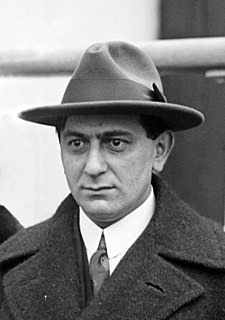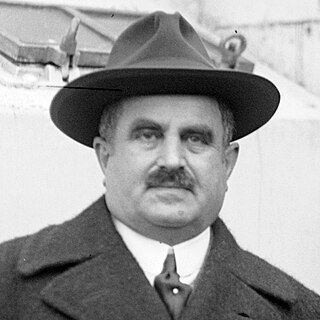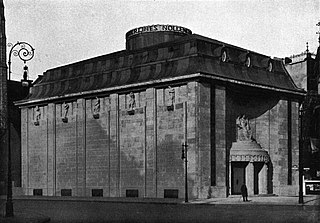
Ernst Lubitsch was a German-born American film director, producer, writer, and actor. His urbane comedies of manners gave him the reputation of being Hollywood's most elegant and sophisticated director; as his prestige grew, his films were promoted as having "the Lubitsch touch". Among his best known works are Trouble in Paradise, Design for Living, Ninotchka, The Shop Around the Corner, To Be or Not to Be and Heaven Can Wait.

Emil Jannings was a German actor, popular in the 1920s in Hollywood. He was the first recipient of the Academy Award for Best Actor for his roles in The Last Command and The Way of All Flesh. As of 2022, Jannings is the only German ever to have won the category.
UFA GmbH, shortened to UFA, is a film and television production company that unites all production activities of the media conglomerate Bertelsmann in Germany. Its name derives from Universum-Film Aktiengesellschaft, a major German film company headquartered in Babelsberg, producing and distributing motion pictures from 1917 until the end of the Nazi era. The name UFA was revived by Bertelsmann for an otherwise unrelated film and television outfit, UFA GmbH.

Pola Negri was a Polish stage and film actress and singer. She achieved worldwide fame during the silent and golden eras of Hollywood and European film for her tragedienne and femme fatale roles and was acknowledged as a sex symbol.

Joe May was an Austrian film director and film producer and one of the pioneers of German cinema.
The European Film Fund (EFF), also known as the European Relief Fund, was a non-profit organization established by the talent agent and producer Paul Kohner.
Fritz Arno Wagner is considered one of the most acclaimed German cinematographers from the 1920s to the 1950s. He played a key role in the Expressionist film movement during the Weimar period and is perhaps best known for excelling "in the portrayal of horror" according to noted film critic Lotte H. Eisner.

Sumurun is a 1920 German silent film directed by Ernst Lubitsch based on a pantomime by Friedrich Freksa.

Paul Davidson was a German film producer.
Jules Greenbaum was a German pioneering film producer. He founded the production companies Deutsche Bioscope, Deutsche Vitascope and Greenbaum-Film and was a dominant figure in German cinema in the years before the First World War. He is also known for his early experiments with sound films around twenty years before the success of The Jazz Singer made them a more established feature of cinema.
Robert and Bertram is a 1915 German silent comedy film directed by Max Mack and starring Eugen Burg, Ferdinand Bonn and Ernst Lubitsch. It is based on the 1856 Gustav Räder play Robert and Bertram about the adventures of two wandering vagrants, which has been turned into films on several occasions.

Prinz Louis Ferdinand is a 1927 German silent historical drama film directed by Hans Behrendt and starring Kurt Junker, Christa Tordy, Hans Stüwe and Jenny Jugo. It was partly shot at the EFA Studios in Berlin. The film's sets were designed by the art director Erich Zander It was based on the life of Prince Louis Ferdinand of Prussia (1772–1806). It was part of the series of Prussian films made during Weimar Germany.

Continental-Kunstfilm GmbH was a short-lived German film production company based in Berlin, formed in February 1912 by Walter Schmidthässler and Max Rittberger. A large number of Continental-Kunstfilm's productions are now probably lost, although some significant films have survived into the 21st century.

Melody of the Heart is a 1929 German musical film directed by Hanns Schwarz and starring Dita Parlo, Willy Fritsch and Gerő Mály.
The Projektions-AG Union was a German film production company which operated between 1911 and 1924 during the silent era. From 1917 onwards, the company functioned as an independent unit of Universum Film AG, and was eventually merged into it entirely.

When Four Do the Same is a 1917 German silent comedy drama film directed by Ernst Lubitsch and starring Ossi Oswalda, Emil Jannings and Margarete Kupfer. Lubitsch himself plays a book shop employee who falls in love with Jannings' daughter. The film was a key transitional work in Lubitsch's career, as he began to produce films with greater depth than his early light comedies.
Staaken Studios was a film studio located in Staaken on the outskirts of the German capital Berlin. A large former zeppelin hangar, it was converted to film use following the First World War and operated during the Weimar Republic. In July 1923 it was the largest studio in the world, with floor space of around 18,000 square feet. It was used for the construction of massive sets on a series of major productions of the silent era, including I.N.R.I., Metropolis, The Holy Mountain and The Ship of Lost Souls. These epics were a part of the German attempt on world markets during the decade. The 1927 Anglo-German co-production The Ghost Train was shot at Staaken.

The Ufa-Pavillon am Nollendorfplatz was a cinema located at 4 Nollendorfplatz, Schöneberg, Berlin. Built in 1912–13 and designed and decorated by leading artistic practitioners of the day, it was the German capital's first purpose-built, free-standing cinema Described as "historically, [...] the most important cinema in Berlin", it incorporated a number of technical innovations such as an opening roof and a daylight projection screen, and opened as the Nollendorf-Theater in March 1913.

The Tempelhof Studios are a film studio located in Tempelhof in the German capital of Berlin. They were founded in 1912, during the silent era, by German film pioneer Alfred Duskes, who built a glass-roofed studio on the site with financial backing from the French company Pathé. The producer Paul Davidson's PAGU then took control and constructed a grander structure. The First World War propaganda drama The Yellow Passport, the historical comedy Madame DuBarry and the expressionist 1920 silent film The Golem were made there by PAGU.

The Weissensee Studios was a collection of separate film production studios located in the Berlin suburb of Weißensee during the silent era.













